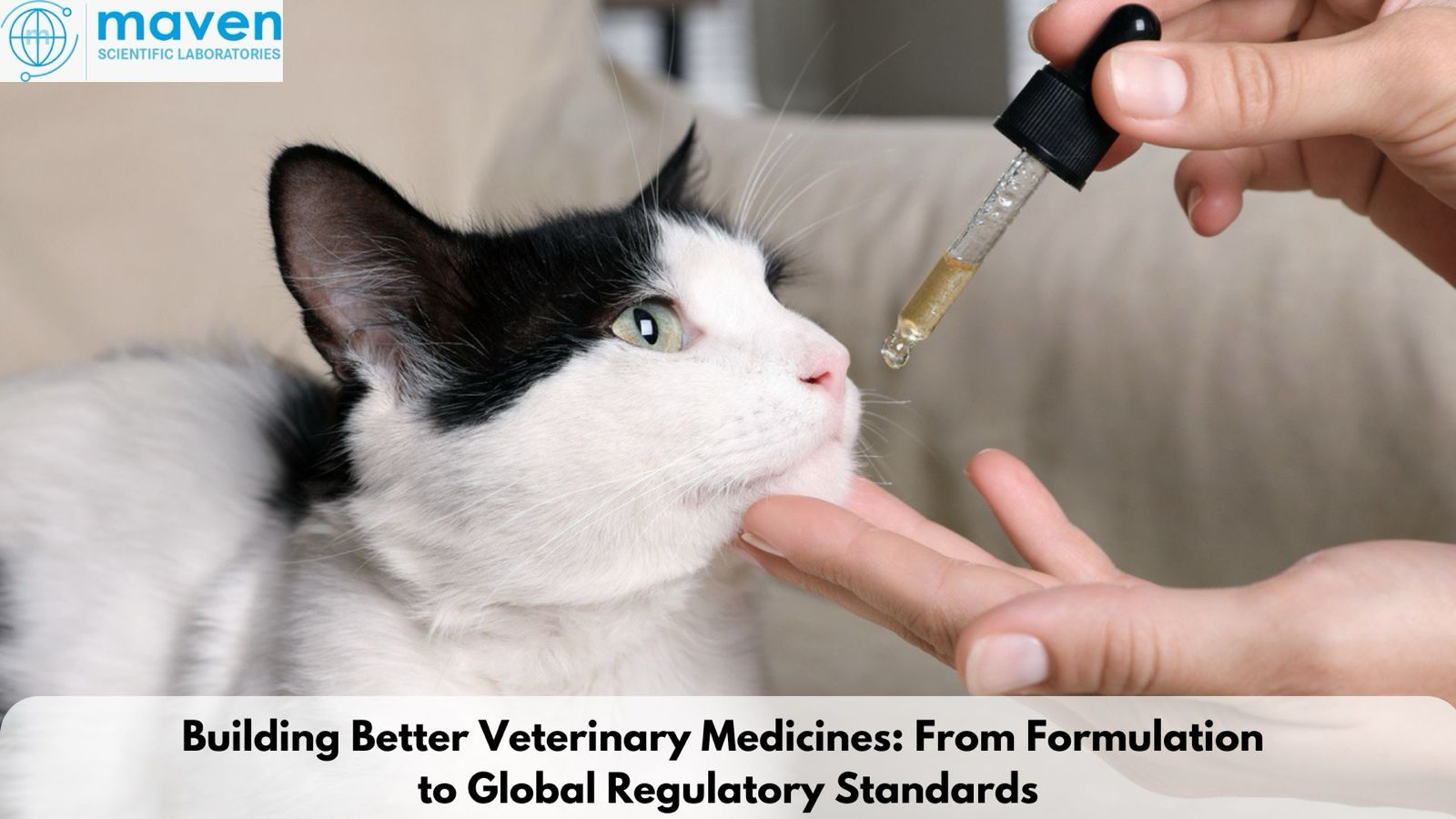
Building Better Veterinary Medicines: From Formulation To Global Regulatory Standards
The veterinary pharmaceutical industry operates in a highly complex and regulated landscape. From addressing the diverse physiological needs of animals to meeting stringent global regulatory requirements, developing veterinary medicinal products demands scientific precision, strategic planning, and comprehensive safety assessments. This blog provides an in-depth overview of the challenges, regulatory, and solutions essential to the successful development and commercialization of veterinary pharmaceuticals.
Navigating Bioequivalence (BE) Challenges
Bioequivalence studies are critical for veterinary medicinal products, particularly for generic drug approval. However, the path to demonstrating BE involves multiple hurdles, including species-specific variations and compliance with region-specific guidelines.
Key Challenges
- Diverse Animal Species: Variations in physiology, metabolism, and drug absorption rates require tailored study designs.
- Dosage Forms and Administration: Differences in formulations (e.g., oral, topical, injectable) and administration methods complicate comparative studies.
- Region-Specific Guidelines: Regulatory bodies like the FDA/CVM, EMA, and VICH (Veterinary International Conference on Harmonization) have distinct requirements for BE studies.
Solutions
- Customized Study Design: Tailored in vivo and in vitro BE studies accounting for species-specific pharmacokinetics (PK) and pharmacodynamics (PD).
- Advanced Statistical Analysis: Application of robust statistical models to interpret BE data in compliance with regional standards.
- Comparative Formulation Assessments: Comprehensive evaluations of global reference products versus local veterinary formulations to ensure equivalence.
Regulatory Guidelines for Veterinary Pharmaceuticals
Navigating the regulatory landscape is crucial for achieving market approval. Key global regulatory bodies and their guidelines include:
1. United States (FDA/CVM)
- Guidelines:
Guidance for Industry (GFI) #35: Bioequivalence Studies for Animal Drugs.
GFI #171: Waivers for In Vivo Bioequivalence Studies.
- Focus: Ensuring the safety and efficacy of veterinary drugs for both animals and humans, including food safety for products derived from treated animals.
2. European Union (EMA)
- Guidelines:
EMA/CVMP/016/00: Guideline on Bioequivalence Studies for Veterinary Medicinal Products.
EMA/CVMP/144/99: Safety Guidelines for Residues in Food-Producing Animals.
- Focus: Harmonizing safety and efficacy standards while promoting animal welfare and environmental sustainability.
3. Veterinary International Conference on Harmonization (VICH)
- Guidelines:
VICH GL52: Statistical Evaluation of BE Studies.
VICH GL33: Stability Testing of New Veterinary Drug Substances.
- Focus: Harmonizing technical requirements across regions to facilitate global approvals.
4. Other Jurisdictions
- Japan: PMDA guidelines for veterinary pharmaceuticals align with VICH standards.
- India: Regulatory framework overseen by the Central Drugs Standard Control Organization (CDSCO), focusing on food safety and antimicrobial resistance.
- Australia: APVMA guidelines emphasize environmental and ecological safety in addition to product efficacy.
Comprehensive Safety Assessments
Safety evaluations are fundamental to ensuring that veterinary medicinal products meet regulatory standards and protect animal health, human health, and the environment.
1. Toxicological Assessments
- Acute and Chronic Toxicity: Evaluations of potential short- and long-term health effects in animals.
- Carcinogenicity and Mutagenicity: Identifying risks of cancer and genetic mutations.
- Reproductive and Developmental Toxicity: Ensuring no adverse effects on animal fertility or offspring.
2. Residue Analysis for Food-Producing Animals
- Maximum Residue Levels (MRLs): Determining safe levels of drug residues in meat, milk, eggs, and other animal products.
- Withdrawal Periods: Establishing mandatory intervals between drug administration and animal product harvesting to ensure food safety.
3. Environmental Risk Assessments (ERAs)
- Ecosystem Safety: Evaluating the impact of veterinary drugs on soil, water, and non-target organisms, including beneficial insects and aquatic species.
- Bioaccumulation Risks: Identifying and mitigating the potential for environmental contamination.
4. Antimicrobial Resistance (AMR) Monitoring
- Assessing the potential for veterinary antibiotics to contribute to AMR in animals and humans.
- Developing strategies to mitigate AMR risks through responsible drug usage and stewardship programs.
Innovative Solutions for Veterinary Drug Development
Addressing the complexity of veterinary medicinal products requires innovative approaches:
1. Species-Specific Formulations
- Palatability: Designing formulations that are acceptable to animals, ensuring adherence.
- Ease of Administration: Developing user-friendly dosage forms for livestock and companion animals.
2. Advanced Analytical Methods
- Pharmacokinetic and Bioanalytical Studies: Leveraging advanced techniques to optimize drug absorption, distribution, metabolism, and excretion (ADME).
- Residue Testing: Employing state-of-the-art methods to detect and quantify drug residues in food products.
3. Integrated Quality Assurance
- Rigorous quality control protocols across the manufacturing process to ensure consistency and compliance.
- Continuous performance assessments to maintain product reliability.
Global Reach with Regional Expertise
Veterinary medicinal companies must balance global ambitions with local regulatory requirements. Key strategies include:
- Regulatory Harmonization: Advocating for standardized guidelines to reduce redundant studies and promote animal welfare.
- Collaborative Innovation: Partnering with industry experts to develop novel solutions for complex challenges.
- Localized Compliance: Tailoring regulatory submissions and labelling to meet region-specific expectations.
Conclusion
The veterinary pharmaceutical industry plays a vital role in enhancing animal health and welfare while safeguarding public health and the environment. By addressing the complexities of bioequivalence, adhering to stringent regulatory standards, and conducting comprehensive safety assessments, veterinary medicinal companies can deliver high-quality, effective, and globally compliant products.
A future-focused approach that embraces innovation and regulatory expertise is essential for success in this evolving landscape. By leveraging tailored solutions and a global perspective, veterinary pharmaceutical companies can overcome challenges, seize opportunities, and contribute to the well-being of animals and humans alike.







